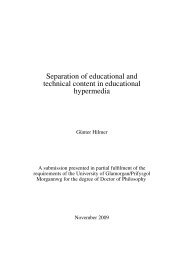framework for the implementation of a virtual design studio model in ...
framework for the implementation of a virtual design studio model in ...
framework for the implementation of a virtual design studio model in ...
Create successful ePaper yourself
Turn your PDF publications into a flip-book with our unique Google optimized e-Paper software.
technology <strong>in</strong> architecture <strong>design</strong> education despite <strong>the</strong> great <strong>in</strong>vestment<br />
<strong>in</strong> acquir<strong>in</strong>g <strong>the</strong> latest technology. This research will <strong>in</strong>vestigate <strong>the</strong> best<br />
practice <strong>of</strong> technology <strong>in</strong> <strong>design</strong> education worldwide. The research will<br />
also determ<strong>in</strong>e <strong>the</strong> UAE‟s need and requirement <strong>of</strong> <strong>the</strong> use <strong>of</strong><br />
technology to support <strong>design</strong> education. This is done aim<strong>in</strong>g to prepare<br />
architects that are suitable <strong>for</strong> <strong>the</strong> countries ambitious mission <strong>for</strong> <strong>the</strong><br />
future. Based on <strong>the</strong> ga<strong>the</strong>red <strong>in</strong><strong>for</strong>mation <strong>the</strong> research will <strong>for</strong>mulate a<br />
<strong>framework</strong> <strong>for</strong> implement<strong>in</strong>g <strong>the</strong> acquired technology <strong>in</strong> architectural<br />
<strong>design</strong> education tak<strong>in</strong>g <strong>in</strong> consideration <strong>the</strong> socio-cultural issues <strong>of</strong> <strong>the</strong><br />
UAE society.<br />
1.2 The importance <strong>of</strong> Us<strong>in</strong>g Technology <strong>in</strong> Education<br />
The vast advances <strong>in</strong> <strong>in</strong><strong>for</strong>mation technology (IT) and <strong>the</strong> availability <strong>of</strong><br />
computer systems encourage its application <strong>in</strong> <strong>the</strong> delivery <strong>of</strong><br />
architectural <strong>design</strong> education. Researchers 2,3 have actively<br />
<strong>in</strong>vestigated <strong>the</strong> potential <strong>of</strong> us<strong>in</strong>g technology <strong>in</strong> <strong>the</strong> education system.<br />
Many studies 4,5,6 have documented <strong>the</strong> positive impact <strong>of</strong> technology on<br />
learn<strong>in</strong>g. O<strong>the</strong>r studies 7,8,9 suggested that <strong>the</strong>re are several factors that<br />
moderate <strong>the</strong> extent to which <strong>the</strong> use <strong>of</strong> technology <strong>in</strong>fluences student<br />
learn<strong>in</strong>g. These studies p<strong>in</strong>po<strong>in</strong>ted proper technology <strong>in</strong>tegration <strong>in</strong>to<br />
<strong>the</strong> curricula as one <strong>of</strong> <strong>the</strong> most dom<strong>in</strong>at<strong>in</strong>g factors. O‟Leary 10 states<br />
that <strong>the</strong> enormous advance <strong>in</strong> computers and Computer Aided Learn<strong>in</strong>g<br />
2 Bates, A. W. (2005). Technology, e-learn<strong>in</strong>g and distance education. New York: Routledge.<br />
3 Hung, D. T., Cheung, S. C., and Hu, C. (2004). ‘Support<strong>in</strong>g problem solv<strong>in</strong>g with case stories learn<strong>in</strong>g<br />
scenario and video-based collaborative learn<strong>in</strong>g technology’. Educational Technology and Society. 7(2).<br />
p120-128.<br />
4 Krentler, K. A., & Willis-Flurry, L. A. (2005). ‘Does technology enhance actual student learn<strong>in</strong>g: <strong>the</strong> case<br />
<strong>of</strong> onl<strong>in</strong>e discussion boards’. Journal <strong>of</strong> education <strong>for</strong> bus<strong>in</strong>ess. 80. p316. 316-321.<br />
5 Kulik, J. A. (1994). ‘Meta-analytic studies <strong>of</strong> f<strong>in</strong>d<strong>in</strong>gs on computer-based <strong>in</strong>struction’. Technology<br />
Assessment <strong>in</strong> Education and Tra<strong>in</strong><strong>in</strong>g. p95, 92-103.<br />
6 Siv<strong>in</strong>-Kachala, J. & Bialo, E. (2000). Research report on <strong>the</strong> effectiveness <strong>of</strong> technology <strong>in</strong> schools.<br />
Wash<strong>in</strong>gton, DC: S<strong>of</strong>tware and In<strong>for</strong>mation Industry Association.<br />
7 Wu, H. K., Hsu, Y. H., Hwang, F. K. (2008). ‘Factors affect<strong>in</strong>g teachers adoption <strong>of</strong> technology <strong>in</strong><br />
classrooms: does school size matter?’. International Journal <strong>of</strong> Science and Ma<strong>the</strong>matics Education. 6,<br />
(1). p69, 63-85<br />
8 Reffat, R. (2002). ‘Design<strong>in</strong>g with computers <strong>in</strong> a paperless <strong>design</strong> comput<strong>in</strong>g <strong>studio</strong>’. In Eshaq, A.,<br />
Khong, C., Neo, M., Ahmad, S. (eds). Proceed<strong>in</strong>gs <strong>of</strong> <strong>the</strong> 7th International Conference on Computer Aided<br />
Architectural Design Research <strong>in</strong> Asia (CAADRIA). New York :Prentice Hall. p347-354.<br />
9 Fensham, P. J. (2008). ‘Science education policy-mak<strong>in</strong>g eleven emerg<strong>in</strong>g issues’. UNESCO Section <strong>for</strong><br />
Science, Technical and Vocational Education. p20.<br />
10 O'Rielly (1999). ‘Introduction’. In Architectural Knowledge and Cultural Diversity, Proceed<strong>in</strong>gs <strong>of</strong> <strong>the</strong> 5th<br />
Colloquium on Architecture and Behavior held between April 6-8, 1998, <strong>in</strong> Ascona, Switzerland. p7<br />
12



